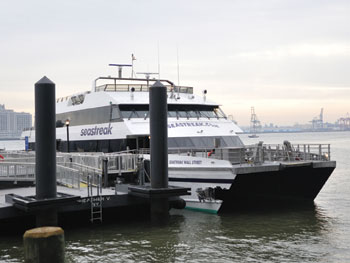A commuter ferry struck a New York City pier in January 2013 as a result of the captain losing control because he was unaware the propulsion system was in backup mode, the National Transportation Safety Board has determined.
Eighty people were injured when Seastreak Wall Street struck Pier 11 in Lower Manhattan. The accident occurred Jan. 9, 2013, as the high-speed passenger ferry was carrying commuters from New Jersey. The boat was traveling at about 12 knots.
“The captain’s usual method of transferring control from one bridge station to another during the approach to the pier did not allow sufficient time and distance to react to the loss of vessel control,” said the board’s investigative report, issued in April 2014.
The NTSB said a contributing factor was “Seastreak LLC’s ineffective oversight of vessel operations.”
Of the 331 people on board, 79 passengers and one crewmember were injured, four seriously.
The agency said the severity of injuries was increased by the company’s “lack of procedures to limit passenger access to stairwells on the Seastreak Wall Street during potentially high-risk situations such as vessel docking and undocking.” The safety of passengers was further hindered because “immediately prior to the accident, no audible alarm was sounded nor did the captain make an announcement to inform passengers of the emergency.”
Seastreak LLC, of Atlantic Highlands, N.J., did not respond to a request for comment.
During the approach for docking, the captain intended to reduce speed and transfer control from one bridge station to another less than a minute before reaching Pier 11 on the East River. Seastreak captains routinely used this procedure and changed stations for better visibility, the report said.
Earlier in the trip, the report said, the captain had shifted the vessel from the normal combinator mode to the infrequently used backup mode. The report said as he approached the dock, he was not aware he had not transferred the propulsion system back to combinator mode. In backup mode, the propellers remained in forward pitch position, causing the vessel to increase forward speed rather than slow.
In 2012, Seastreak Wall Street underwent major modifications, converting the vessel’s engines from waterjet to controllable pitch propeller propulsion. The board said that although vessel owners and operators are responsible for updating documents to reflect changes in equipment, the boat’s operating manual had not been updated. Additionally, it said that following the changes, the company did not institute a formal training program for operation of the new system. However, the NTSB added, the captain was trained by the manufacturer and he trained other Seastreak captains on the new system.
“While the Seastreak Wall Street is the third ferry accident the NTSB has investigated in New York City in the last decade, we found areas of risk identified in previous investigations,” NTSB Chairman Deborah A.P. Hersman said. “Seastreak LLC had no safety management system in place to identify risks and take corrective actions.”
She noted that the NTSB recommended that these management systems be required in 2005 and the Coast Guard was provided the authority to require them by Congress in 2010, but the systems are still not required for domestic passenger vessels. “It is time to require that every passenger vessel implement an SMS,” she said.
A management system would have required the company to maintain current safety documents, train employees to integrate safe practices into routine operations and emergency preparations and clearly define the roles of the crew so the captain would have proper assistance during an emergency.
“The NTSB’s investigation of this accident was also hampered by the absence of a voyage data recorder, which would have captured critical information to assist in the investigation,” the report stated.
As a result of the accident, the NTSB recommended that:
— The Coast Guard improve standards for critical vessel controls, operator control of ferry passenger access to stairwells, and carrying marine voyage data recorders.
— The owner of Seastreak Wall Street improve control system displays and alerts, complete development and implementation of a safety management system, and revise its vessel operations and training manuals.
— The manufacturer of the propulsion control system improve its design and alert its customers to the changes.

